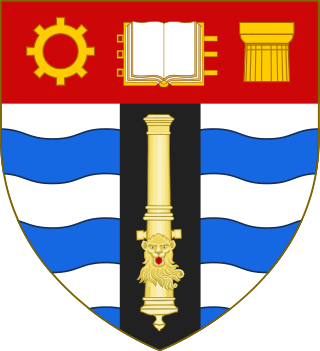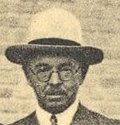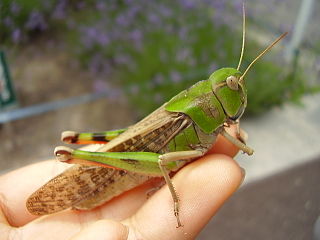Related Research Articles

Locusts are various species of short-horned grasshoppers in the family Acrididae that have a swarming phase. These insects are usually solitary, but under certain circumstances they become more abundant and change their behaviour and habits, becoming gregarious. No taxonomic distinction is made between locust and grasshopper species; the basis for the definition is whether a species forms swarms under intermittently suitable conditions; this has evolved independently in multiple lineages, comprising at least 18 genera in 5 different subfamilies.

The University of Greenwich is a public university located in London and Kent, United Kingdom. Previous names include Woolwich Polytechnic and Thames Polytechnic.

The Medical Research Council (MRC) is responsible for co-coordinating and funding medical research in the United Kingdom. It is part of United Kingdom Research and Innovation (UKRI), which came into operation 1 April 2018, and brings together the UK's seven research councils, Innovate UK and Research England. UK Research and Innovation is answerable to, although politically independent from, the Department for Business, Energy and Industrial Strategy.

The desert locust is a species of locust, a periodically swarming, short-horned grasshopper in the family Acrididae. They are found primarily in the deserts and dry areas of northern and eastern Africa, Arabia, and southwest Asia. During population surge years, they may extend north into parts of Southern Europe, south into Eastern Africa, and east in northern India. The desert locust shows periodic changes in its body form and can change in response to environmental conditions, over several generations, from a solitary, shorter-winged, highly fecund, non-migratory form to a gregarious, long-winged, and migratory phase in which they may travel long distances into new areas. In some years, they may thus form locust plagues, invading new areas, where they may consume all vegetation including crops, and at other times, they may live unnoticed in small numbers.

The Council of Scientific and Industrial Research is a research and development (R&D) organisation in India to promote scientific, industrial and economic growth. Headquartered in New Delhi, it was established as an autonomous body in 1942 under the aegis of the Department of Scientific and Industrial Research (DSIR), Ministry of Science and Technology, Government of India. CSIR is among the largest publicly funded R&D organisations in the world. CSIR has pioneered sustained contribution to science and technology (S&T) human resource development in India.

The red locust is a large grasshopper species found in sub-Saharan Africa. Its name refers to the colour of its hind wings. It is sometimes called the criquet nomade in French, due to its nomadic movements in the dry season. When it forms swarms, it is described as a locust.

Silwood Park is the rural campus of Imperial College London, England. It is situated near the village of Sunninghill, near Ascot in Berkshire. Since 1986, there have been major developments on the site with four new college buildings. Adjacent to these buildings is the Technology Transfer Centre: a science park with units leased to commercial companies for research.
Leslie Desmond Edward Foster-Vesey-Fitzgerald MBE, was an Irish-born entomologist, ornithologist, conservationist, and plant collector.

The brown locust is a medium-sized small locust species in the monotypic genus Locustana. It is found in Southern Africa and shows classic gregarious behaviour with phase polymorphism on crowding.

Sir Boris Petrovitch Uvarov was a Russian-British entomologist best known for his work on the biology and ecology of locusts. He has been called the father of acridology.
George Anthony Beattie was a British civil servant, born in London. He began a public service career as a development economist in Africa in the 1960s and ended it in 2004 as a Director in the UK's Department for International Development (DFID). He helped promote the application of New Public Management concepts to the UK public sector in the 1990s, both as head of the Natural Resources Institute, then part of the Overseas Development Administration, for ten years from 1986 until its transfer to the University of Greenwich in 1996, and subsequently as a member of the Efficiency and Effectiveness Unit in the Cabinet Office. From 1997 to 2004, Beattie was Ambassador and UK Permanent Representative to the UN Food and Agriculture Agencies in Rome. Among other roles in the governing bodies in Rome he was President of the Executive Board of the World Food Programme (WFP), chair of the Audit Committee of the Executive Board of the International Fund for Agricultural Development (IFAD) and Vice-Chair of the Finance Committee of the Food and Agriculture Organization (FAO). He chaired the Governance Group established by WFPs Executive Board in 1999. He has trained as a coach at Henley Management College and implemented a coaching programme in WFP. He was also active in charity governance as a chair and trustee, and was a member of the Governance Forum of the National Council of Voluntary Organisations. Prior to his death he was undertaking a consultancy for the CGIAR fund Council on resource mobilisation. He died in Johannesburg on 31 March 2014 after having had a fall in Dar es Salaam on 19 March 2014.
The International Pesticide Application Research Consortium (IPARC), previously known as the International Pesticide Application Research Centre and before that the Overseas Spray Machinery Centre (OSMC), has focused on pesticide application methods appropriate for smallholder farmers since 1955. It is now a research and training group whose purpose is to promote practical and cost-effective techniques, wherever possible, reducing the use of chemical pesticides, as part of Integrated Pest Management (IPM). IPARC has been an integral part of pesticide research and teaching at Silwood Park and has specialised in the needs of smallholder farmers, application techniques for migrant pests and control of disease vectors. IPARC is a World Health Organization (WHO) collaborating centre.

George Basil Popov MBE, was a Russian-British entomologist born in Iran, his father having been employed there by the Imperial Bank of Persia. Popov became an authority on the Desert locust.

Locusta migratoria manilensis, commonly known as the Oriental migratory locust, is a subspecies of the migratory locust in the family Acrididae. It is sufficiently different in size and structure from the African migratory locust to be considered a distinct subspecies of the migratory locust. It is found in southeastern Asia and is an important agricultural pest in the region. It is normally a solitary insect but when conditions are suitable, it enters into a gregarious phase when the young form into bands which move together and the adults into swarms. Although outbreaks may have recently been fewer in number and size because of changes in agricultural practices and better locust detection, the insects remain active as crop pests and the potential for outbreaks is still present.
Dr Andrew Rodger Waterston OBE FRSE FRES was a Scottish zoologist, specialising in malacology and entomology. He was interested in the insect fauna of the Middle East and in the fauna of the Outer Hebrides. He was generally known as Rodger Waterston.
William Robin Thompson was a Canadian entomologist and also wrote on the philosophy of science in his book Science and Common Sense: An Aristotelian Excursion (1937). He specialized in the biological control of agricultural and forest insects and served as the head of a laboratory of the Imperial Institute of Entomology which changed its name from the Imperial Parasite Service to Imperial Bureau of Biological Control and later the Commonwealth Institute of Biological Control.
Maud J. Norris was an English entomologist known for her work on insect pheromones and the physiology of insect development and maturation. A significant part of her career was spent on the study of locusts at the Anti-Locust Research Centre. She was the first to describe what are now called primer pheromones.
Nadejda "Nadia" Waloff FRES was a Russian-born English entomologist. She worked on the biology of locusts, flight and dispersal of the Hemiptera, and taught at Imperial College, Silwood Park campus.
Gabriella "Gay" Gibson FRES is a medical entomologist in the UK, she specialises in mosquitoes. In 2013 she was appointed Professor of Medical Entomology at the University of Greenwich.
Anthony Youdeowei is a Nigerian professor of Agricultural Entomology. He was acting vice chancellor, dean and executive chairman at the University of Ibadan Publishing House. He is a founding fellow of the African Academy of Sciences and The World Academy of Sciences.
References
- 1 2 "National Resources Institute: History". University of Greenwich. Archived from the original on 2015-04-14. Retrieved 2015-04-06.
- 1 2 "Anti-Locust Research Centre Archive". Natural History Museum. Retrieved 2015-04-06.
- ↑ New Scientist. Reed Business Information. 20 April 1972. p. 156. ISSN 0262-4079.
- ↑ "News: Anti-Locust Research Centre". Nature. 158: 231–232. 1946. doi: 10.1038/158231d0 .